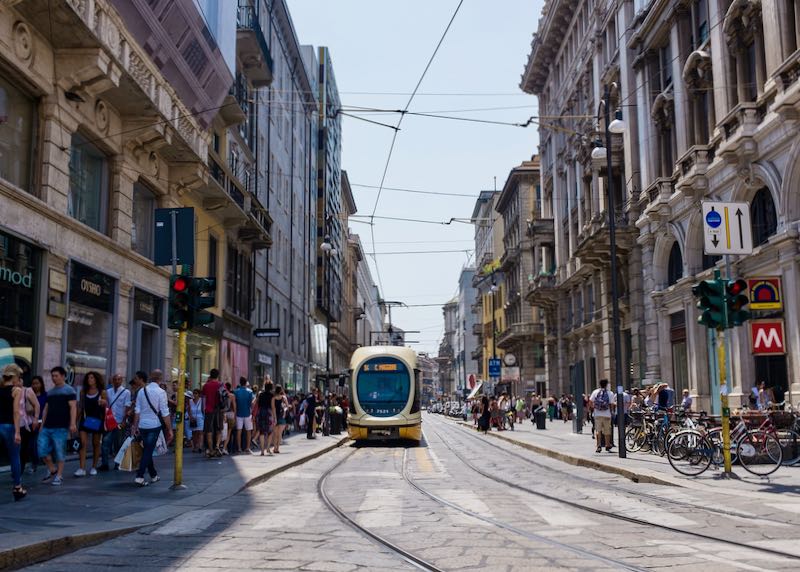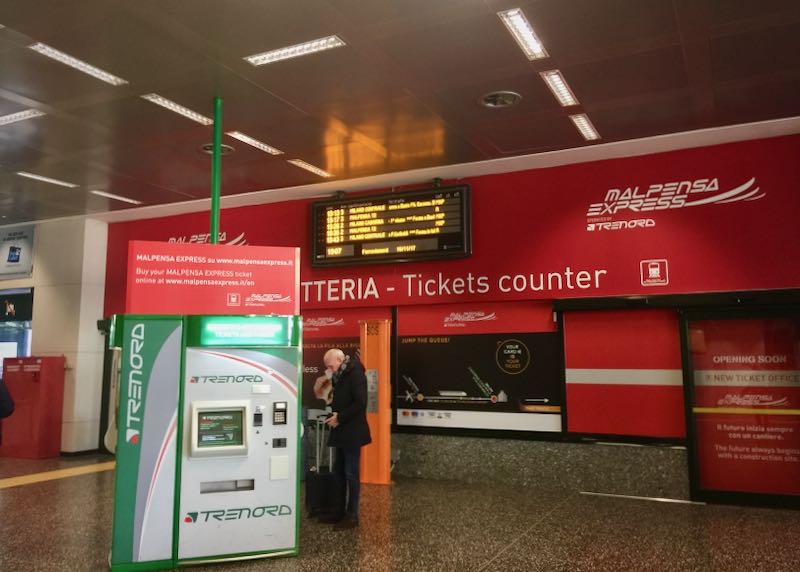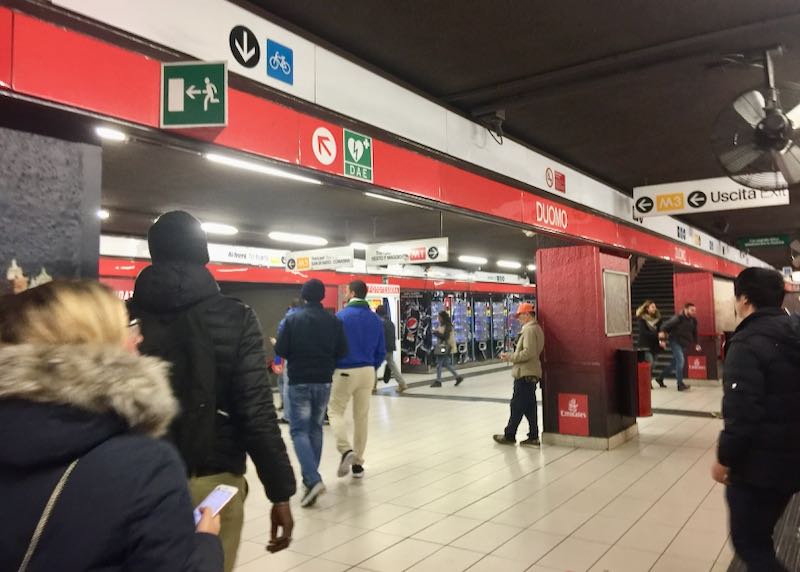SD › Italy › Milan › Getting Around
Updated: April 28, 2022
By Santorini Dave

Trams (streetcars) are one of the fastest and easiest ways to get around Milan.
Milan is not a difficult place to drive, but like any major city that dates to medieval times, the layout of the roads can be confusing, parking is expensive, and many of the best places are closed to cars. Luckily, Milan is blessed with the best public transit system in all of Italy; an efficient network of metros, buses, and trams work together to get you most anywhere you’d want to go. Rideshare services like Uber operate here as well, along with taxis who will usually pull over when hailed from the sidewalk. In recent years, bike shares have cropped up around town, providing another option for quick trips. More often than not, though, walking will suffice, as Milan’s primary tourist area is fairly compact — most major sights are within a 20-minute radius from the Duomo in the city center.
The only downside to Milan’s transit options is that there are so many. It can be a struggle to figure out what combination of metros, trams, buses, and walking paths is most efficient and/or enjoyable. Happily, modern technology provides a variety of phone applications to help you figure it out. Google Maps and Citymapper, for instance, will allow you to input a destination from your current location, and will spit out multiple transport options with connection points for each one right there in the map grid, along with arrival times. Milan’s public transit company, ATM, also has a transport app that will even allow you to purchase tickets on your phone. It’s worth spending a little more money for an amended short-term international data plan, particularly if you don’t have a lot of time in the city and need to make the most of it. Also be aware that your GPS will generally work even in the absence of a data plan (or even in airplane mode), so you can still use that to get your bearings.
It’s also not difficult to make your way tech-free with the help of a good transit map, which are available at:
- Most any hotel desk (if you’re staying in an Airbnb, just drop into a hotel and ask for one, if your hosts don’t provide one.)
- Any of the metro transfer point stations in the city center (Garibaldi, Centrale FS, Cadorna, or Duomo.)
- Any drugstore (farmacia) or tobacco store (tabacchi), which also usually will be able to sell you ATM tickets (“ATM” is an acronym for Milan’s public transport company), covering metro, trams, and buses.
Getting from the Airport to Central Milan

Ticket counter for the Malpensa Express shuttle train to central Milan from Malpensa Airport.
Most flights coming into Milan arrive at Milan’s Malpensa Airport.
- The easiest way to get between the Malpensa airport and Milan city center is to pre-book transfer through Welcome Pickups car service. English speaking drivers monitor your flight and meet you at arrivals, eliminating the need to navigate the airport on your own. Price is similar to that of a taxi (around €115), and child car seats are available by request. The trip to central Milan will take about 50 minutes, traffic-depending.
- The Malpensa Express train offers devoted service between the airport and all three of Milan’s central train stations: Cadorna, on the west side of town, Garibaldi in the north, and Centrale on the northeast edge. The train also makes six stops in smaller towns between Milan and the airport, but the Express is still an excellent, fast, and cheap option. It leaves roughly every 30 minutes between 5am and midnight, with a station located right in the airport. Cost is €13 euros, and the trip takes about an hour. (Note that there are actually two Express train lines; one goes to Cadorna, and the other makes stops at both Garibaldi and Centrale. The airport station has them clearly marked; have a look at a map and see which station is nearest to your final destination, then choose accordingly.)
- Several buses serve Malpensa Airport, including a shuttle that leaves every 20 minutes and drops off in central Milan, costing €8. This takes about 50 minutes, or more with traffic. At the airport, shuttle stops are located at exit gate 3 of Terminal 1 and exit gate 7 of Terminal 2, just outside the arrivals hall.
- Taxis are also available at the airport, and will take you into the city for a fixed fee of €90. Taxi stands are located at exit gate 6 of Terminal 1 and at exit gate 4 of Terminal 2, outside of the arrivals hall. (Official cabs should be white, and will have a sticker that says “Taxi autorizzato per il servizio aeroportuale Lombardo.”)
Linate Airport and Milan Bergamo Il Caravaggio International Airport (also known as Orio al Serio International Airport) are the other two airports in the area. Buses and taxis are available at both locations (Linate is closer to town, and will thus be cheaper), with buses generally dropping off at the Centrale station.
Milan Public Transportation

The busy Duomo metro station acts as as a transfer point for many metro lines.
Milan’s coordinated ticketing system allows passengers to buy one pass that covers metro, trams, and buses with one purchase. Most stations have kiosks selling single-ticket trips (€2, valid over a 90-minute period after first stamping) or day passes (€4.50), and those tickets are good across the entire ATM network. If you’re going to be in Milan for more than a couple days, you might consider the 10-ticket package (€13.80).
Tickets are also available to purchase at newsstands, in tobacco shops, and by using the ATM Milano official app.
Metro
Milan has four metro lines that wind through the city, with many centrally-located stops near major tourist destinations and areas of interest. They are designated both with colors (red, green, yellow, and purple) and numbers (M1, M2, M3, and M5). Any hotel or tourist center will be able to provide a basic map of the layout; try to find one that superimposes a street grid so you can more easily find the stops. Service starts early (around 5:40am) and stops a little after midnight.
All metro stations in the city center have LED screens displaying train arrivals, but you will rarely wait more than five minutes for a train to arrive. Navigating the stations is pretty easy, although it is helpful to know the end points of the lines, which will help you figure out which direction is the correct one based on where you’re going. Every station has two sides, so you need to know which one to be on; before you descend to the actual loading area, there are signs indicating what stops are served on that particular side. Look for your station on the signs, and walk down to the appropriate side when you see it listed. Fours stations (Garibaldi, Centrale FS, Cadorna, and Duomo) act as hubs for multiple metro lines, which adds a layer of complexity, but as long as you know either the name or the color of your particular line, it’s very easy to follow the abundant signage.
The line most often used by visitors to Milan is M3: it has stops near attractions like Milano Centrale railway station, the Duomo, and the popular shopping street Via Montenapoleone. The Milan metro runs from 6am to midnight.
Detailed information, metro route maps, and information about the ATM transit app can be found on the ATM Milano website.
Tram
Ideal for short trips across certain sections of town, Milan’s trams are essentially streetcars on devoted rails, strategically located to get you around those areas the metro doesn’t reach, with stops situated very close to each other in a dense urban network. And they are quite charming to boot. Milan’s trams have been in service for nearly 140 years, and while there are a mix of styles for the cars, stepping onto one of the older ones is like going back in time, with wood panels, shiny metal poles, dome lights, and giant picture windows to enjoy. Tram maps are available online or inside city-center hotels, and numbered according to the line. Each stop has a sign posted indicating the other stops on that line, along with the times they are scheduled to arrive. There are no “real time” readers at tram stops, but the trams are generally reliable and arrive within a couple minutes or less of the posted times (unless there’s a transportation strike happening). Trams run from 4:30am to 2:30am.
The density of the tram system can make it difficult to figure out what side of the street to wait on. Consult the signs at the stops, which will have arrows indicating which way that particular tram is heading along its route. If you’re still not sure, many of the tram operators speak English and are happy to help. Usually, though, it’s not too hard to figure out which side to be on if you know what direction your destination is from the stop. Having a map to consult on your cell phone is always for this. It’s important to remember to stamp/validate your ticket when getting on the tram – not doing so can result in a hefty fine.
Bus
Where metro lines or trams can’t take you, buses can. Like tram stops, bus stops all have posted schedules indicating arrival times, and are usually fairly reliable. The bus grid serves a broader area than the trams lines, however, and therefore are slightly more prone to lateness. Remember to stamp/validate your ticket when getting on the bus, or you risk incurring a fine.
Rental Cars
Milan is a compact, walkable city, and parking is difficult and expensive. We do not recommend renting a car for your stay in Milan. If Milan is a jumping-off point for a larger Italy adventure, we suggest renting a car through RentalCars.com. They offer reputable international brands and their easy-to-use website makes it simple to find the best deal. Be sure to reserve ahead if you require an automatic transmission. Also, remember that an International Driving Permit is required by law if you plan to operate a vehicle in Italy for any length of time.
Taxis
There are designated taxi ranks spread throughout the city, where cabs are usually waiting and plentiful. A hotel doorman or concierge will be happy to call you one, or you can use the Free Now app to call one yourself – without having to know Italian. Hailing a taxi from the street has become easier in recent years, as Milan seems to have relaxed – or at least rarely enforces – the city law that forbids it. Having said that, you may find many taxis passing you by if you are hailing from a busy area where it’s difficult to stop. Try to find a location that offers a convenient place for them to pull over, and you’ll have more luck.
Most cabs in Milan accept credit cards, but it’s a good idea to ask when entering the taxi. And be aware that many taxi drivers speak very little English, so have an address or the name of your destination (drivers will recognize major landmarks) ready to go.
Rideshare
Milan is one of the few Italian cities in which Uber operates. Standards are stricter in Italy than in the US for Uber drivers, however; all Uber drivers in Italy are required to be professional drivers, and the rate might be higher than Uber in other countries.
Bikes
Milan is relatively small and entirely flat, which makes biking an efficient method for getting around. There is some dodging of traffic and pedestrians, and it’s important to watch out for road hazards like train tracks and potholes, but otherwise it’s easy and safe. Within the city center, bikes can be rented through a “dockless” bike share service: BikeMi. Simply download the BikeMi app to locate available bikes nearby. In the center of town, you will rarely have to walk more than a block or two to find an available option. After entering your credit card information, use the app to scan and unlock a bike for a small fee. Prices vary, but you will not pay more than a few euro at the most for trips under an hour.
Be sure to lock the bike when you finish with it, or someone else can ride it on your tab. You can also rent a bike the old fashioned way from a number of different vendors in town; look online or try the tourist information booths in the train stations (Garibaldi, Centrale, or Cadorna), or the ones near the Duomo in the city center. Most hotels will be able to steer you toward a service nearby as well.
On Foot
The city center is very walkable, and with the help of a good map and a basic sense of the city’s layout, traveling on foot is often your best option. You will get the best feel for the city this way, and because the layout of the town is completely flat, you’ll be able to go long distances without too much trouble. Be sure to wear comfortable shoes (but also reasonably stylish…you are in Milan, after all.)
About Santorini Dave